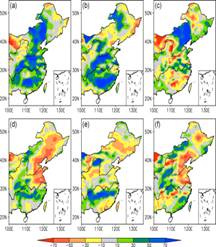Droughts and floods are the two most costly climate disasters over China. However, our ability to predict droughts and floods is limited by poor understanding of the atmospheric response to long memory climate drivers such as sea surface temperature and soil moisture. An anomaly in soil moisture can alter latent heat flux and other surface energy balance components, and subsequently influence the climate at a variety of time and space scales. Some previous studies have explored the effects of soil moisture on summer climate over China or East Asia. Regional climate models have been found to have better ability to simulate land-atmosphere interactions and regional characteristics compared to atmospheric general circulation model. Eastern China experienced severe floods during the summer of 1998, while 1999 summer is characterized by a “southern flood and northern drought” pattern. The study investigates that soil moisture feedbacks on summer droughts and floods over eastern China for the 1998 and 1999 cases using the Weather Research and Forecasting (WRF) model simulations. Soil moisture climatology, derived from a 20-year-long control run, is used to replace soil moisture evolution in uncoupled simulations for 1998 and 1999 summers. The study has been published in Chinese Science Bulletin, the lead author is Dr. Lingyun Wu at LASG and coauthor is Prof. Jingyong Zhang at CMSR.
The WRF model generally simulates relatively well the droughts and floods in the two summers. Without interactive soil moisture, the WRF model cannot, to a large extent, capture both droughts and floods over northern China. However, that is not the case for southern China. Precipitation anomalies over southern China can be reproduced in the simulations both with and without interactive soil moisture. The results indicate that soil moisture plays a substantial role in northern China droughts and floods while it has a relatively small ability to affect precipitation anomalies over southern China. The study suggests that the memory inherent in soil moisture can help improve prediction skills of summer droughts and floods over northern China, even in El Ni?o/La Ni?a years.

Figure: Soil moisture feedbacks on precipitation anomalies in the summers of 1998 (top) and 1999 (bottom). (a), (d) simulated summer precipitation anomalies relative to 1980–1999 summer climatology in CTL; (b), (e) simulated summer precipitation anomalies relative to 1980–1999 summer climatology in 98SoilM and 99SoilM; (c), (f) precipitation differences between CTL and uncoupled experiments (CTL minus 98SoilM, and CTL minus 99SoilM).
More information at:
http://csb.scichina.com:8080/kxtbe/EN/abstract/abstract507999.shtml
